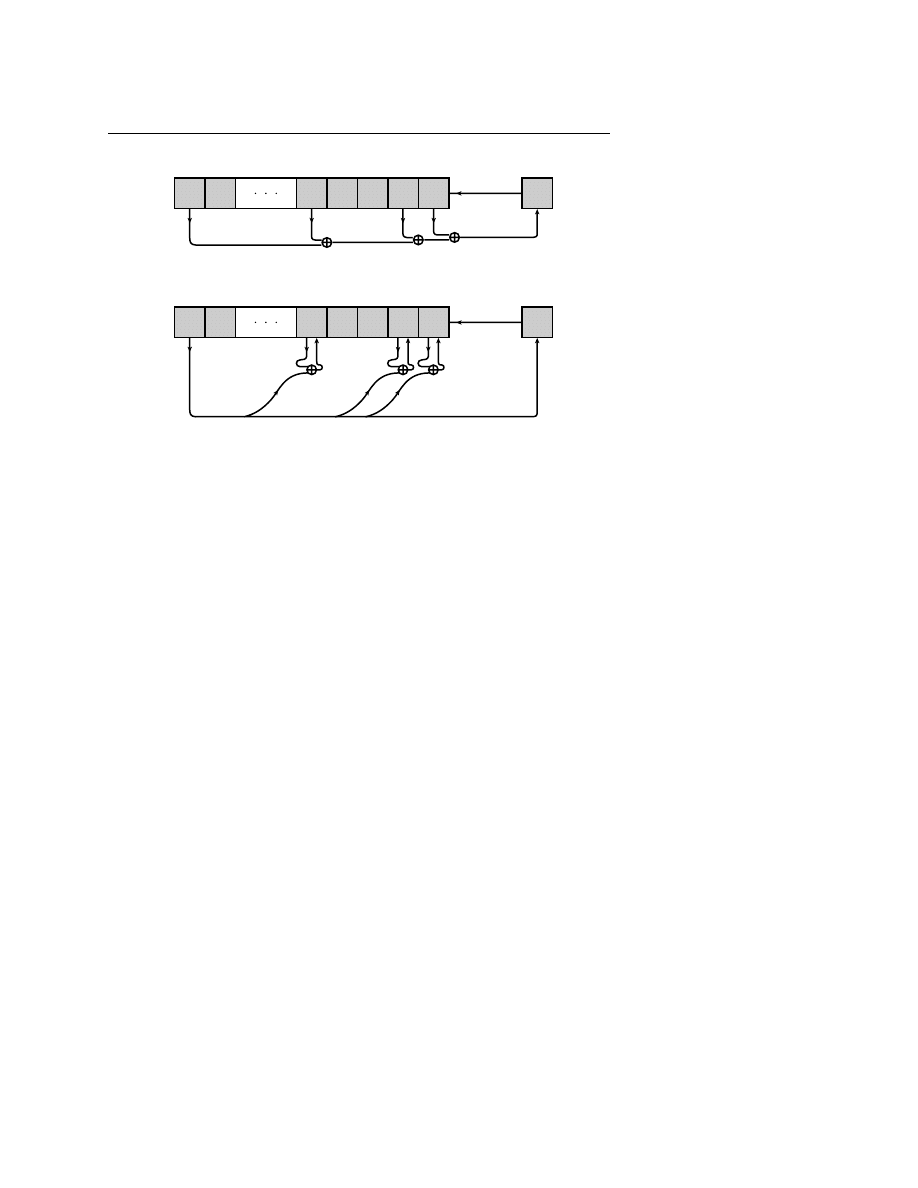
296
Chapter 7.
Random Numbers
Sample page from NUMERICAL RECIPES IN C: THE ART OF SCIENTIFIC COMPUTING (ISBN 0-521-43108-5)
Copyright (C) 1988-1992 by Cambridge University Press.
Programs Copyright (C) 1988-1992 by Numerical Recipes Software.
Permission is granted for internet users to make one paper copy for their own personal use. Further reproduction, or any copyin
g of machine-
readable files (including this one) to any server
computer, is strictly prohibited. To order Numerical Recipes books
or CDROMs, v
isit website
http://www.nr.com or call 1-800-872-7423 (North America only),
or send email to directcustserv@cambridge.org (outside North Amer
ica).
if (n != nold) {
If n has changed, then compute useful quanti-
ties.
en=n;
oldg=gammln(en+1.0);
nold=n;
} if (p != pold) {
If p has changed, then compute useful quanti-
ties.
pc=1.0-p;
plog=log(p);
pclog=log(pc);
pold=p;
}
sq=sqrt(2.0*am*pc);
The following code should by now seem familiar:
rejection method with a Lorentzian compar-
ison function.
do {
do {
angle=PI*ran1(idum);
y=tan(angle);
em=sq*y+am;
} while (em < 0.0 || em >= (en+1.0));
Reject.
em=floor(em);
Trick for integer-valued distribution.
t=1.2*sq*(1.0+y*y)*exp(oldg-gammln(em+1.0)
-gammln(en-em+1.0)+em*plog+(en-em)*pclog);
} while (ran1(idum) > t);
Reject. This happens about 1.5 times per devi-
ate, on average.
bnl=em;
}
if (p != pp) bnl=n-bnl;
Remember to undo the symmetry transforma-
tion.
return bnl;
}
See Devroye
[2]
and Bratley
[3]
for many additional algorithms.
CITED REFERENCES AND FURTHER READING:
Knuth, D.E. 1981, Seminumerical Algorithms, 2nd ed., vol. 2 of The Art of Computer Programming
(Reading, MA: Addison-Wesley), pp. 120ff. [1]
Devroye, L. 1986, Non-Uniform Random Variate Generation (New York: Springer-Verlag),
§
X.4.
[2]
Bratley, P., Fox, B.L., and Schrage, E.L. 1983, A Guide to Simulation (New York: Springer-
Verlag). [3].
7.4 Generation of Random Bits
The
C language gives you useful access to some machine-level bitwise operations
such as
<< (left shift). This section will show you how to put such abilities to good use.
The problem is how to generate single random bits, with 0 and 1 equally
probable. Of course you can just generate uniform random deviates between zero
and one and use their high-order bit (i.e., test if they are greater than or less than
0.5). However this takes a lot of arithmetic; there are special-purpose applications,
such as real-time signal processing, where you want to generate bits very much
faster than that.
One method for generating random bits, with two variant implementations, is
based on “primitive polynomials modulo 2.” The theory of these polynomials is
beyond our scope (although
§7.7 and §20.3 will give you small tastes of it). Here,

7.4 Generation of Random Bits
297
Sample page from NUMERICAL RECIPES IN C: THE ART OF SCIENTIFIC COMPUTING (ISBN 0-521-43108-5)
Copyright (C) 1988-1992 by Cambridge University Press.
Programs Copyright (C) 1988-1992 by Numerical Recipes Software.
Permission is granted for internet users to make one paper copy for their own personal use. Further reproduction, or any copyin
g of machine-
readable files (including this one) to any server
computer, is strictly prohibited. To order Numerical Recipes books
or CDROMs, v
isit website
http://www.nr.com or call 1-800-872-7423 (North America only),
or send email to directcustserv@cambridge.org (outside North Amer
ica).
suffice it to say that there are special polynomials among those whose coefficients
are zero or one. An example is
x
18
+ x
5
+ x
2
+ x
1
+ x
0
(7.4.1)
which we can abbreviate by just writing the nonzero powers of
x, e.g.,
(18, 5, 2, 1, 0)
Every primitive polynomial modulo 2 of order
n (=18 above) defines a recurrence
relation for obtaining a new random bit from the
n preceding ones. The recurrence
relation is guaranteed to produce a sequence of maximal length, i.e., cycle through
all possible sequences of
n bits (except all zeros) before it repeats. Therefore one
can seed the sequence with any initial bit pattern (except all zeros), and get
2
n
− 1
random bits before the sequence repeats.
Let the bits be numbered from 1 (most recently generated) through
n (generated
n steps ago), and denoted a
1
, a
2
, . . . , a
n
. We want to give a formula for a new bit
a
0
. After generating
a
0
we will shift all the bits by one, so that the old
a
n
is finally
lost, and the new
a
0
becomes
a
1
. We then apply the formula again, and so on.
“Method I” is the easiest to implement in hardware, requiring only a single
shift register
n bits long and a few XOR (“exclusive or” or bit addition mod 2)
gates, the operation denoted in
C by “∧”. For the primitive polynomial given above,
the recurrence formula is
a
0
= a
18
∧ a
5
∧ a
2
∧ a
1
(7.4.2)
The terms that are
∧’d together can be thought of as “taps” on the shift register,
∧’d into the register’s input. More generally, there is precisely one term for each
nonzero coefficient in the primitive polynomial except the constant (zero bit) term.
So the first term will always be
a
n
for a primitive polynomial of degree
n, while the
last term might or might not be
a
1
, depending on whether the primitive polynomial
has a term in
x
1
.
While it is simple in hardware, Method I is somewhat cumbersome in
C, because
the individual bits must be collected by a sequence of full-word masks:
int irbit1(unsigned long *iseed)
Returns as an integer a random bit, based on the 18 low-significance bits in
iseed
(which is
modified for the next call).
{
unsigned long newbit;
The accumulated XOR’s.
newbit = (*iseed >> 17) & 1
Get bit 18.
^ (*iseed >> 4) & 1
XOR with bit 5.
^ (*iseed >> 1) & 1
XOR with bit 2.
^ (*iseed & 1);
XOR with bit 1.
*iseed=(*iseed << 1) | newbit;
Leftshift the seed and put the result of the
XOR’s in its bit 1.
return (int) newbit;
}

298
Chapter 7.
Random Numbers
Sample page from NUMERICAL RECIPES IN C: THE ART OF SCIENTIFIC COMPUTING (ISBN 0-521-43108-5)
Copyright (C) 1988-1992 by Cambridge University Press.
Programs Copyright (C) 1988-1992 by Numerical Recipes Software.
Permission is granted for internet users to make one paper copy for their own personal use. Further reproduction, or any copyin
g of machine-
readable files (including this one) to any server
computer, is strictly prohibited. To order Numerical Recipes books
or CDROMs, v
isit website
http://www.nr.com or call 1-800-872-7423 (North America only),
or send email to directcustserv@cambridge.org (outside North Amer
ica).
18
17
5
4
3
2
1
0
shift left
(a)
18
17
5
4
3
2
1
0
shift left
(b)
Figure 7.4.1.
Two related methods for obtaining random bits from a shift register and a primitive
polynomial modulo 2. (a) The contents of selected taps are combined by exclusive-or (addition modulo
2), and the result is shifted in from the right. This method is easiest to implement in hardware. (b)
Selected bits are modified by exclusive-or with the leftmost bit, which is then shifted in from the right.
This method is easiest to implement in software.
“Method II” is less suited to direct hardware implementation (though still
possible), but is beautifully suited to
C. It modifies more than one bit among the
saved
n bits as each new bit is generated (Figure 7.4.1). It generates the maximal
length sequence, but not in the same order as Method I. The prescription for the
primitive polynomial (7.4.1) is:
a
0
= a
18
a
5
= a
5
∧ a
0
a
2
= a
2
∧ a
0
a
1
= a
1
∧ a
0
(7.4.3)
In general there will be an exclusive-or for each nonzero term in the primitive
polynomial except 0 and
n. The nice feature about Method II is that all the
exclusive-or’s can usually be done as a single full-word exclusive-or operation:
#define IB1 1
Powers of 2.
#define IB2 2
#define IB5 16
#define IB18 131072
#define MASK (IB1+IB2+IB5)
int irbit2(unsigned long *iseed)
Returns as an integer a random bit, based on the 18 low-significance bits in
iseed
(which is
modified for the next call).
{
if (*iseed & IB18) {
Change all masked bits, shift, and put 1 into bit 1.
*iseed=((*iseed ^ MASK) << 1) | IB1;
return 1;
} else {
Shift and put 0 into bit 1.

7.4 Generation of Random Bits
299
Sample page from NUMERICAL RECIPES IN C: THE ART OF SCIENTIFIC COMPUTING (ISBN 0-521-43108-5)
Copyright (C) 1988-1992 by Cambridge University Press.
Programs Copyright (C) 1988-1992 by Numerical Recipes Software.
Permission is granted for internet users to make one paper copy for their own personal use. Further reproduction, or any copyin
g of machine-
readable files (including this one) to any server
computer, is strictly prohibited. To order Numerical Recipes books
or CDROMs, v
isit website
http://www.nr.com or call 1-800-872-7423 (North America only),
or send email to directcustserv@cambridge.org (outside North Amer
ica).
*iseed <<= 1;
return 0;
}
}
Some Primitive Polynomials Modulo 2 (after Watson)
(1,
0)
(51,
6,
3,
1,
0)
(2,
1,
0)
(52,
3,
0)
(3,
1,
0)
(53,
6,
2,
1,
0)
(4,
1,
0)
(54,
6,
5,
4,
3,
2,
0)
(5,
2,
0)
(55,
6,
2,
1,
0)
(6,
1,
0)
(56,
7,
4,
2,
0)
(7,
1,
0)
(57,
5,
3,
2,
0)
(8,
4,
3,
2,
0)
(58,
6,
5,
1,
0)
(9,
4,
0)
(59,
6,
5,
4,
3,
1,
0)
(10,
3,
0)
(60,
1,
0)
(11,
2,
0)
(61,
5,
2,
1,
0)
(12,
6,
4,
1,
0)
(62,
6,
5,
3,
0)
(13,
4,
3,
1,
0)
(63,
1,
0)
(14,
5,
3,
1,
0)
(64,
4,
3,
1,
0)
(15,
1,
0)
(65,
4,
3,
1,
0)
(16,
5,
3,
2,
0)
(66,
8,
6,
5,
3,
2,
0)
(17,
3,
0)
(67,
5,
2,
1,
0)
(18,
5,
2,
1,
0)
(68,
7,
5,
1,
0)
(19,
5,
2,
1,
0)
(69,
6,
5,
2,
0)
(20,
3,
0)
(70,
5,
3,
1,
0)
(21,
2,
0)
(71,
5,
3,
1,
0)
(22,
1,
0)
(72,
6,
4,
3,
2,
1,
0)
(23,
5,
0)
(73,
4,
3,
2,
0)
(24,
4,
3,
1,
0)
(74,
7,
4,
3,
0)
(25,
3,
0)
(75,
6,
3,
1,
0)
(26,
6,
2,
1,
0)
(76,
5,
4,
2,
0)
(27,
5,
2,
1,
0)
(77,
6,
5,
2,
0)
(28,
3,
0)
(78,
7,
2,
1,
0)
(29,
2,
0)
(79,
4,
3,
2,
0)
(30,
6,
4,
1,
0)
(80,
7,
5,
3,
2,
1,
0)
(31,
3,
0)
(81,
4
0)
(32,
7,
5,
3,
2,
1,
0)
(82,
8,
7,
6,
4,
1,
0)
(33,
6,
4,
1,
0)
(83,
7,
4,
2,
0)
(34,
7,
6,
5,
2,
1,
0)
(84,
8,
7,
5,
3,
1,
0)
(35,
2,
0)
(85,
8,
2,
1,
0)
(36,
6,
5,
4,
2,
1,
0)
(86,
6,
5,
2,
0)
(37,
5,
4,
3,
2,
1,
0)
(87,
7,
5,
1,
0)
(38,
6,
5,
1,
0)
(88,
8,
5,
4,
3,
1,
0)
(39,
4,
0)
(89,
6,
5,
3,
0)
(40,
5,
4
3,
0)
(90,
5,
3,
2,
0)
(41,
3,
0)
(91,
7,
6,
5,
3,
2,
0)
(42,
5,
4,
3,
2,
1,
0)
(92,
6,
5,
2,
0)
(43,
6,
4,
3,
0)
(93,
2,
0)
(44,
6,
5,
2,
0)
(94,
6,
5,
1,
0)
(45,
4,
3,
1,
0)
(95,
6,
5,
4,
2,
1,
0)
(46,
8,
5,
3,
2,
1,
0)
(96,
7,
6,
4,
3,
2,
0)
(47,
5,
0)
(97,
6,
0)
(48,
7,
5,
4,
2,
1,
0)
(98,
7,
4,
3,
2,
1,
0)
(49,
6,
5,
4,
0)
(99,
7,
5,
4,
0)
(50,
4,
3,
2,
0)
(100,
8,
7,
2,
0)
A word of caution is: Don’t use sequential bits from these routines as the bits
of a large, supposedly random, integer, or as the bits in the mantissa of a supposedly

300
Chapter 7.
Random Numbers
Sample page from NUMERICAL RECIPES IN C: THE ART OF SCIENTIFIC COMPUTING (ISBN 0-521-43108-5)
Copyright (C) 1988-1992 by Cambridge University Press.
Programs Copyright (C) 1988-1992 by Numerical Recipes Software.
Permission is granted for internet users to make one paper copy for their own personal use. Further reproduction, or any copyin
g of machine-
readable files (including this one) to any server
computer, is strictly prohibited. To order Numerical Recipes books
or CDROMs, v
isit website
http://www.nr.com or call 1-800-872-7423 (North America only),
or send email to directcustserv@cambridge.org (outside North Amer
ica).
random floating-point number. They are not very random for that purpose; see
Knuth
[1]
. Examples of acceptable uses of these random bits are: (i) multiplying a
signal randomly by
±1 at a rapid “chip rate,” so as to spread its spectrum uniformly
(but recoverably) across some desired bandpass, or (ii) Monte Carlo exploration
of a binary tree, where decisions as to whether to branch left or right are to be
made randomly.
Now we do not want you to go through life thinking that there is something
special about the primitive polynomial of degree 18 used in the above examples.
(We chose 18 because
2
18
is small enough for you to verify our claims directly by
numerical experiment.) The accompanying table
[2]
lists one primitive polynomial
for each degree up to 100. (In fact there exist many such for each degree. For
example, see
§7.7 for a complete table up to degree 10.)
CITED REFERENCES AND FURTHER READING:
Knuth, D.E. 1981, Seminumerical Algorithms, 2nd ed., vol. 2 of The Art of Computer Programming
(Reading, MA: Addison-Wesley), pp. 29ff. [1]
Horowitz, P., and Hill, W. 1989, The Art of Electronics, 2nd ed. (Cambridge: Cambridge University
Press),
§§
9.32–9.37.
Tausworthe, R.C. 1965, Mathematics of Computation, vol. 19, pp. 201–209.
Watson, E.J. 1962, Mathematics of Computation, vol. 16, pp. 368–369. [2]
7.5 Random Sequences Based on Data
Encryption
In Numerical Recipes’ first edition, we described how to use the Data Encryption Standard
(DES)
[1-3]
for the generation of random numbers. Unfortunately, when implemented in
software in a high-level language like C, DES is very slow, so excruciatingly slow, in fact, that
our previous implementation can be viewed as more mischievous than useful. Here we give
a much faster and simpler algorithm which, though it may not be secure in the cryptographic
sense, generates about equally good random numbers.
DES, like its progenitor cryptographic system LUCIFER, is a so-called “block product
cipher”
[4]
. It acts on 64 bits of input by iteratively applying (16 times, in fact) a kind of highly
nonlinear bit-mixing function. Figure 7.5.1 shows the flow of information in DES during
this mixing. The function g, which takes 32-bits into 32-bits, is called the “cipher function.”
Meyer and Matyas
[4]
discuss the importance of the cipher function being nonlinear, as well
as other design criteria.
DES constructs its cipher function g from an intricate set of bit permutations and table
lookups acting on short sequences of consecutive bits. Apparently, this function was chosen
to be particularly strong cryptographically (or conceivably as some critics contend, to have
an exquisitely subtle cryptographic flaw!). For our purposes, a different function g that can
be rapidly computed in a high-level computer language is preferable. Such a function may
weaken the algorithm cryptographically. Our purposes are not, however, cryptographic: We
want to find the fastest g, and smallest number of iterations of the mixing procedure in Figure
7.5.1, such that our output random sequence passes the standard tests that are customarily
applied to random number generators. The resulting algorithm will not be DES, but rather a
kind of “pseudo-DES,” better suited to the purpose at hand.
Following the criterion, mentioned above, that g should be nonlinear, we must give the
integer multiply operation a prominent place in g. Because 64-bit registers are not generally
accessible in high-level languages, we must confine ourselves to multiplying 16-bit operands
Wyszukiwarka
Podobne podstrony:
Złamania i zwichnięcia C3 C7(1)
C7 1
C7, 1 STUDIA - Informatyka Politechnika Koszalińska, Labki, Fizyka, sprawka od Mateusza, Fizyka - la
C7 (kolokwium II)
C7 0
Pomiary właściwości cieplnych materiałów izolacyjnych, Pim c7, Politechnika Wrocławska
c++, wyklad c7
Chirurgia C7, studia pielęgniarstwo
C7 MiBM en
C7 2
C7 czy jestem prawdziwym katolikiem
C7 5
Laboratorium jezyk c7 2013
c7-pirometr
C7 (kolokwium II)
so c7
C7 3
c7 3
C7 200611 CAT PL
więcej podobnych podstron